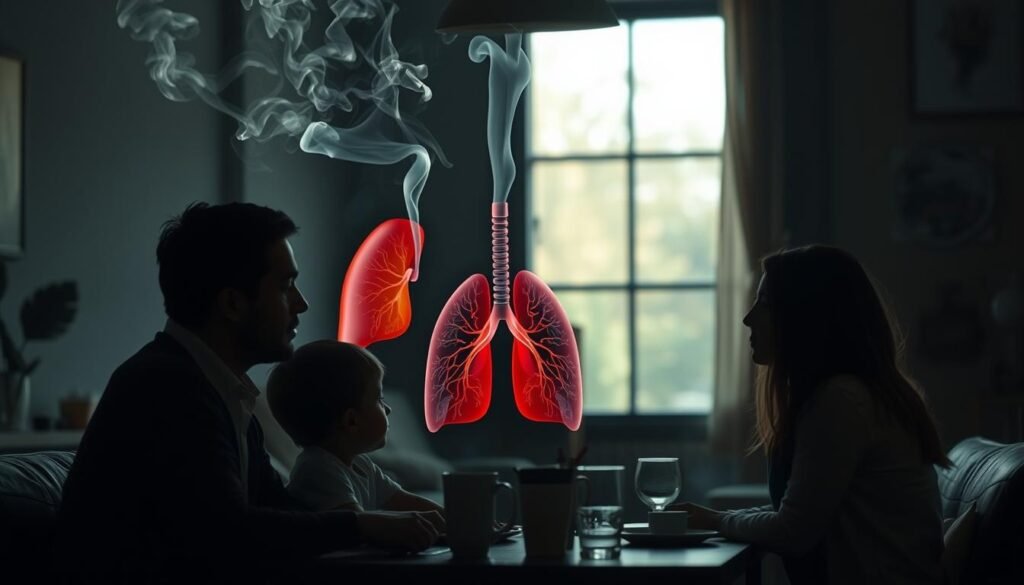Did you know about 85 percent of lung cancer is due to smoking? This fact shows why it’s critical to stop smoking. Quitting is not just a choice; it’s a key move to cut down lung cancer risk and boost health. Studies prove that quitting smoking lowers lung cancer risk over time compared to those still smoking. By knowing how this risk changes after quitting, people can make better health decisions. The first step to lower cancer risk and improve health is to quit smoking. The benefits of stopping are huge and impact more than just the lungs.
Key Takeaways
- Quitting smoking dramatically lowers the risk of lung cancer over time.
- 85% of lung cancer cases are linked to smoking.
- Former smokers experience a 42% lower risk of lung cancer incidence.
- Understanding the risk timeline is crucial for lung cancer prevention.
- Smoking cessation benefits include improved overall health and increased lifespan.
- The risk of lung cancer decreases fastest after quitting, falling significantly within five years.
- Quitting smoking contributes to a substantial reduction in other cancer risks as well.
The Impact of Smoking on Lung Health
Smoking is bad for lung health, causing about 85% of lung cancer deaths. It leads to diseases like emphysema and chronic bronchitis which weaken your lungs. Researchers at Memorial Sloan Kettering Cancer Center have developed tools to check lung cancer risk in smokers.
The effects of smoking last even after quitting. They show the need for lung cancer prevention. Quitting smoking reduces lung cancer risk over time but it doesn’t completely go back to normal. This shows how smoking affects lung health long-term.
Secondhand smoke also causes cancer and heart disease, not just for the smoker. Even light smoking is harmful. It’s important to avoid tobacco to protect your lungs and health.
Smoking causes nearly half a million deaths a year in the U.S. alone. This highlights the importance of quitting smoking programs. Fighting smoking-related diseases is vital for public health. It helps increase awareness and prevention of lung cancer.
Understanding Lung Cancer and Its Connection to Smoking
Lung cancer includes various types like adenocarcinoma and squamous cell carcinoma. The link between smoking and lung cancer is very strong. About 85% of lung cancer cases are due to smoking, showing the need for awareness.
Smoking exposes lungs to harmful compounds. This can damage cells and lead to tumors. If people quit smoking, especially early on, their survival rates can greatly improve.
To illustrate the crucial connection between smoking and lung cancer, here is a table that provides insight into survival rates and risk factors:
| Time Since Quitting | Risk Reduction | Median Survival (years) |
|---|---|---|
| 5 years | Risk drops by 39.1% | N/A |
| 10-15 years | Risk is halved | N/A |
| After Diagnosis (Early Stage) | N/A | 6.6 (quit smoking) vs. 4.8 (continue smoking) |
| N/A | Individuals who continue smoking nearly double their risk of dying | N/A |
Preventing lung cancer focuses on the link to smoking. Knowing about the types of lung cancer from tobacco helps tackle this issue. Doctors stress quitting smoking for good reason. It’s also why regular screening for lung cancer is pushed for early detection and better survival chances.
https://www.youtube.com/watch?v=QDDnYcn-o8I
Benefits of Quitting Smoking
Deciding to quit smoking opens up many health benefits that boost your well-being. Starting on this path leads to quick and lasting health gains. These positives can encourage people to leave smoking behind.
Immediate Health Benefits
When you quit, your body begins to heal right away. You’ll see your heart rate and blood flow get better. Carbon monoxide levels in your blood drop, boosting oxygen transport in your body. Other quick benefits include:
- Improved taste and smell
- Healthier breath
- Better lung function
- Reduced risk of lung cancer and chronic obstructive pulmonary disease (COPD)
Quitting can extend your life by up to 10 years. It’s a key step to a healthier life. For those with lung cancer, stopping smoking can mean a longer, better life. For instance, early-stage lung cancer patients who quit lived longer than those who didn’t. Recent studies support these facts.
Long-term Health Improvements
The good points of quitting smoking keep growing over time. Eventually, your lung ability gets better, and you face less risk of big health issues. Key improvements for the long term include:
- A decreased risk of various cancers, like those of the lung, bladder, and stomach
- Lowered chances of heart disease and stroke
- Better breathing, especially for ex-COPD sufferers
- Less risk of reproductive issues in pregnant women
Quitting early, especially during pregnancy, greatly lowers the risk of low birth weight and complications. Those who stop smoking also dodge heart disease and early death risks, which drop noticeably in just 1-2 years. By quitting, you promote better lung health and dodge many smoking-related diseases, leading to a healthier life ahead. Learn more about quitting’s lasting benefits.
How Lung Cancer Risk Decreases with Time After Quitting Smoking
It’s important to know how stopping smoking affects your lung cancer risk. The longer you stay away from cigarettes, the lower your risk. After five years without smoking, your chances of getting lung cancer drop noticeably.
Five-Year Risk Assessment
Within five years of quitting, former smokers have a 39.1% lower risk of lung cancer. However, their risk is still three times higher than people who never smoked. It’s key to keep up with lung cancer screenings, as they play a big role in catching the disease early. Early detection improves survival rates. Now, the five-year survival rate has gone up to 21.7% from 17.2% a decade ago.
Long-term Observations
The outlook gets even better for ex-smokers as more time passes. Quitting smoking is a big step towards better health. Most lung cancers are found in people who have quit smoking, showing the need to stay smoke-free. Screenings are crucial for early cancer detection and living a healthier life after smoking. Quitting smoking greatly improves your health, making every smoke-free day count. More info on quitting benefits are found here.
Lung Cancer Risk Reduction Timeline
Stopping smoking starts a journey towards lower lung cancer risk. The lung cancer risk reduction timeline shows why quitting is key. Over time, healing begins and the chance of lung cancer drops. This is especially true compared to people who never smoked.
Starting Point: The Day You Quit
Quitting smoking brings immediate body changes. Carbon monoxide levels go back to normal within a day, boosting oxygen levels. This is the start of the quitting smoking timeline. Even heart disease risk starts to fall. Over time, these changes can lead to lower lung cancer risks.
Five Years: Significant Risk Decrease
Five years smoke-free means a lot lower lung cancer risk. Studies show quitting cuts the risk, even though it’s still higher than in never-smokers. This time is crucial for body repair and better lung health, showing a positive move in the lung cancer risk reduction timeline.
15 to 25 Years Post-Quit: Comparisons with Never-Smokers
Years after quitting, the risk keeps dropping. After 15 to 25 years, former smokers have a much lower risk. Yet, about 40% of lung cancers in former smokers are diagnosed over 15 years post-quit. Regular check-ups can help lower this risk even more. This shows that quitting can bring former smokers close to the risk level of never-smokers.
Importance of Lung Cancer Screening
Lung cancer screening is key to better health for people who’ve smoked before. Lung cancer is the top reason people die from cancer around the world. So, we can’t ignore how crucial lung cancer screening is.
Screening Recommendations for Former Smokers
The U.S. Preventive Services Task Force has screening recommendations for former smokers. They say adults between 50 and 80, especially those who have stopped smoking but used to smoke a lot, need yearly screenings. They should get checked using a low-dose computed tomography (CT) scan. This is vital for anyone who smoked a pack a day for 20 years or more. The risk of illness lasts 15 to 20 years even after quitting. Luckily, many insurance plans, like Medicare and Medicaid, cover these screenings.
How Early Detection Improves Outcomes
Finding lung cancer early greatly helps with survival rates. If lung cancer is caught soon through regular screenings, patients have more and better treatment options. Research shows that screening lowers the death rate from lung cancer by 8% to 61%. This depends on how at risk the person is.
Low-dose CT scans are used because they give off 80% less radiation than normal CT scans. Besides finding lung cancer, they can spot other health problems. Heart issues and aneurysms are examples of what they can detect.

| Age Group | Smoking History | Annual Screening Recommendation |
|---|---|---|
| 50-80 | Current smokers or former smokers who quit within the last 15 years with ≥30 pack-years | Yes |
| 50-80 | Former smokers with ≥30 pack-years who quit more than 15 years ago | Consider based on individual risk |
| All | Individual risk factors | Consult healthcare provider |
Risk Factors That Can Influence Lung Cancer After Quitting
Understanding the risk factors for lung cancer is key for people who have stopped smoking. Quitting does lower the lung cancer risk. Yet, some factors can still increase the chance of getting the disease.
Heavy Smoking History
A long history of heavy smoking raises lung cancer risks. Even after quitting, those who smoked a lot for years are still at risk. Studies show smokers are 15 to 30 times more likely to get lung cancer compared to non-smokers. It’s important for former heavy smokers to stay vigilant and get regular health checks.
Family History and Other Environmental Factors
Having cancer in your family history can also up your lung cancer risk. Environmental factors play a big role too. Being around harmful substances like radon gas, asbestos, and certain workplace chemicals can increase cancer risks. So, it’s crucial for ex-smokers to be mindful of these risk factors in their surroundings.
| Risk Factor | Impact |
|---|---|
| Heavy Smoking History | 15 to 30 times higher risk compared to non-smokers |
| Family History of Cancer | Higher likelihood to develop lung cancer |
| Exposure to Radon Gas | Second leading cause of lung cancer, especially in non-smokers |
| Occupational Hazards (e.g., Asbestos) | Significantly increases risk, particularly in those who also smoke |
| Radiation Therapy | Increased risk of developing lung cancer post-treatment |
Secondhand Smoke and Its Risks
Secondhand smoke is still a big health problem, especially for people who used to smoke. The effect of secondhand smoke is serious. Data shows that living with smokers can up the chance of getting lung cancer by 30%. This kind of smoke leads to over 7,300 lung cancer deaths a year in the U.S. among non-smokers. Kids and babies are much more likely to get sick from it. They can get more lung diseases and have a higher risk of Sudden Infant Death Syndrome (SIDS).
Impact of Secondhand Smoke on Former Smokers
People who have stopped smoking need to stay away from secondhand smoke to protect their health. Studies have found that secondhand smoke causes about 34,000 early deaths from heart disease every year in the U.S. Even if you’ve quit, you could still get heart disease and strokes from this smoke. Secondhand smoke isn’t just bad for health; it also hits the economy hard. In 2017, it caused losses worth $7.2 billion. If you’ve quit smoking, you should know about these dangers.
Learn more about the risks.
Strategies for Avoiding Secondhand Smoke
If you’ve quit smoking, there are ways to avoid secondhand smoke. Pushing for smoke-free areas can make a healthier environment. Air purifiers at home can lower smoke levels inside. Telling family and friends to keep their homes smoke-free can also help a lot. Knowing how bad the smoke is, like causing breathing problems in kids, shows why it’s urgent to avoid it. It’s crucial to look at all ways to keep your lungs healthy and live smoke-free.

| Health Risks of Secondhand Smoke | Annual Statistics |
|---|---|
| Lung cancer deaths among non-smokers | 7,300 |
| Premature deaths from heart disease | 34,000 |
| Annual deaths attributed to secondhand smoke | 19,000 |
| Increased risk of stroke | 20-30% |
| Increased risk of coronary heart disease | 25-30% |
| Economic loss due to secondhand smoke exposure | $7.2 billion |
Maintaining a Smoke-Free Lifestyle
Living smoke-free takes more than just deciding to quit. It needs strong support and healthy choices. Joining programs can help you quit for good. This improves your health and lowers your risk of getting cancer.
Support for Smoking Cessation
Getting help is key to quit smoking. Counseling and group sessions can make a big difference. Using nicotine replacements or medications helps too. This combo is best for heavy smokers. It cuts down risks of lung cancer and heart issues.
Healthy Living Practices Post-Smoking
Making healthy choices is crucial after quitting. Here are the key practices:
- Regular exercise keeps you fit and helps your lungs work better.
- Balanced nutrition improves your health and strengthens your immune system.
- Stress management helps control cravings and emotional eating.
Sticking with these habits helps keep you smoke-free. They lower your chance of getting sick, including lung cancer.
| Healthy Living Practices | Benefits |
|---|---|
| Regular Exercise | Improves cardiovascular health and lung capacity. |
| Balanced Nutrition | Strengthens the immune system and aids in recovery. |
| Stress Management | Reduces the likelihood of relapse to smoking. |
Staying smoke-free is a long-term goal. Healthy habits and support systems help a lot. Focusing on health increases your chances of success.
Long-term Health Effects of Quitting Smoking
Quitting smoking leads to major long-term health perks. One top reason to quit is the reduction of cancer risks. Plus, quitting lowers the chance of getting lung, stomach, liver, and colon cancers.
Reduction of Other Cancer Risks
Former smokers greatly cut their cancer risks over time. Research shows that 10 years after quitting, the risk of lung cancer drops by half compared to smokers. This decrease also applies to various other cancer types, showing the wide range of health benefits from quitting.
Improvements in Respiratory Health
The improvements in respiratory health are noticeable. People often see better lung function and fewer cases of chronic diseases post-quitting. This boost in respiratory health is a strong sign of the body’s ability to recover after quitting smoking.

Conclusion
When you stop smoking, the journey to reduce lung cancer risk starts slow but is very rewarding. With each year not smoking, your risk drops, showing how key it is to quit. Studies show a big drop in lung cancer risk one year after quitting, and this keeps getting better.
Understanding how lung cancer risk decreases makes it clear that not smoking anymore brings lifelong health benefits. People who quit smoking when they’re younger can avoid nearly all the extra cancer risk from smoking. This shows the big health benefits for ex-smokers and how their choices help public health.
A smoke-free life leads to healthier communities and reminds us it’s never too late to stop smoking. Even those who quit later can still see big health boosts and a lower risk of lung cancer. The path to a healthier life without smoking’s risks is possible for everyone.